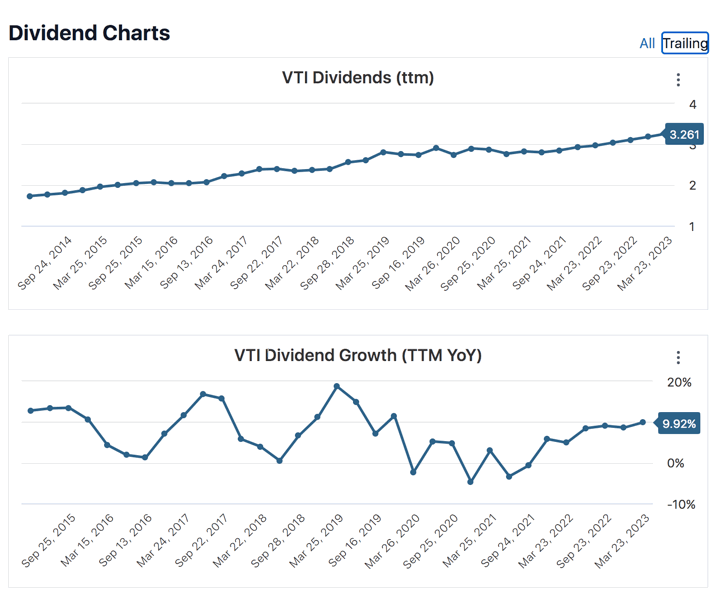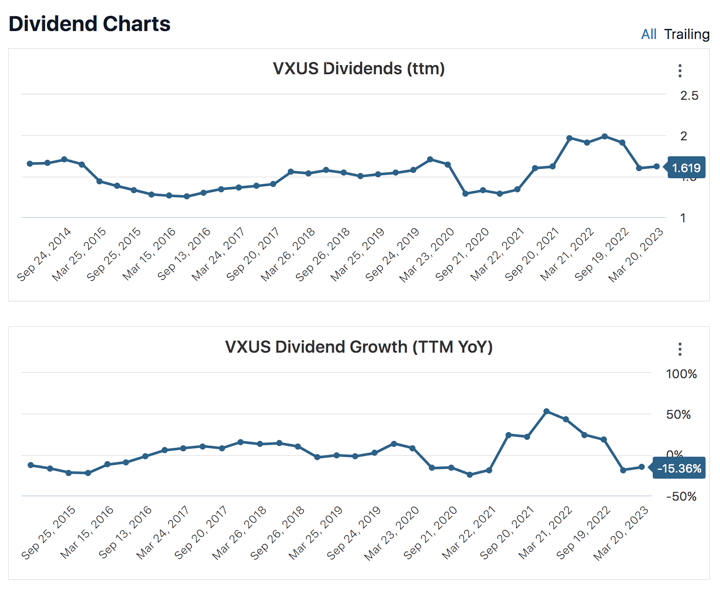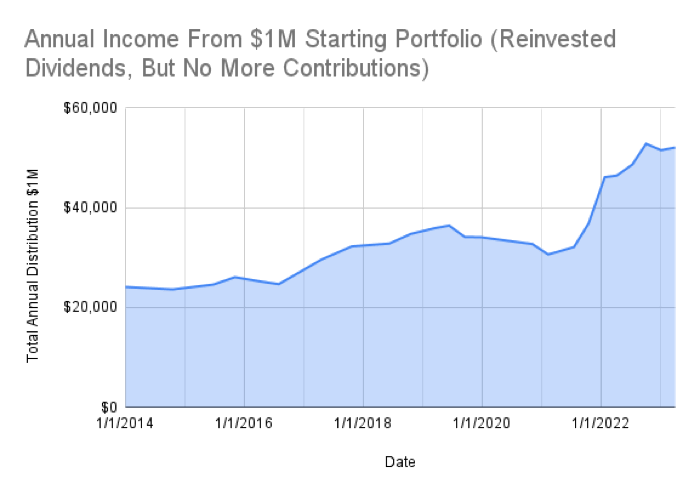 Here’s my 2023 Q1 income update for my Humble Portfolio. I prefer to track the income produced as an alternative metric for performance. The total income goes up much more gradually and consistently than the number shown on brokerage statements (price), which helps encourage consistent investing. I imagine my portfolio as a factory that churns out dollar bills, a tree that gives dividend fruit.
Here’s my 2023 Q1 income update for my Humble Portfolio. I prefer to track the income produced as an alternative metric for performance. The total income goes up much more gradually and consistently than the number shown on brokerage statements (price), which helps encourage consistent investing. I imagine my portfolio as a factory that churns out dollar bills, a tree that gives dividend fruit.
Background about why I track dividends. Stock dividends are a portion of profits that businesses have decided to distribute directly to shareholders, as opposed to reinvesting into their business, paying back debt, or buying back shares. The dividends may suffer some short-term drops, but over the long run they have grown faster than inflation.
In the US, the dividend culture is somewhat conservative in that shareholders expect dividends to be stable and only go up. Thus the starting yield is lower, but grows more steadily with smaller cuts during hard times. Here is the historical growth of the trailing 12-month (ttm) dividend paid by the Vanguard Total US Stock ETF (VTI), courtesy of StockAnalysis.com.

European corporate culture tends to encourage paying out a higher (sometimes fixed) percentage of earnings as dividends, but that also means the dividends move up and down with earnings. Thus the starting yield is higher but may not grow as reliably. Here is the historical growth of the trailing 12-month (ttm) dividend paid by the Vanguard Total International Stock ETF (VXUS).

The dividend yield (dividends divided by price) also serve as a rough valuation metric. When stock prices drop, this percentage metric usually goes up – which makes me feel better in a bear market. When stock prices go up, this percentage metric usually goes down, which keeps me from getting too euphoric during a bull market. Here’s a related quote from Jack Bogle (source):
The true investor will do better if he forgets about the stock market and pays attention to his dividend returns and to the operating results of his companies. – Jack Bogle
My personal portfolio income history. I started tracking the income from my portfolio in 2014. Here’s what the annual distributions from my portfolio look like over time:
- $1,000,000 invested in my portfolio as of January 2014 would started out paying ~$24,000 in annual income over the previous 12 months. (2.4% starting yield)
- If I reinvested the dividends/interest every quarter but added no other contributions, as of April 2023 it would have generated ~$52,000 in annual income over the previous 12 months.
- Even if I SPENT all the dividends/interest every quarter and added no other contributions, as of April 2023 it would have generated ~$40,000 in annual income over the previous 12 months.
This chart shows how the annual income generated by my portfolio has increased over time and with dividend reinvestment.

I’m using simple numbers to illustrate things, but isn’t that a nicer, gentler way to track your progress?
TTM income yield. To estimate the income from my portfolio, I use the weighted “TTM” or “12-Month Yield” from Morningstar (checked 4/2/23), which is the sum of the trailing 12 months of interest and dividend payments divided by the last month’s ending share price (NAV) plus any capital gains distributed (usually zero for index funds) over the same period. The trailing income yield for this quarter was 3.33%, as calculated below. Then I multiply by the current balance from my brokerage statements to get the total income.
| Asset Class / Fund | % of Portfolio | Trailing 12-Month Yield | Yield Contribution |
| US Total Stock (VTI) | 30% | 1.60% | 0.48% |
| US Small Value (VBR) | 5% | 2.20% | 0.11% |
| Int’l Total Stock (VXUS) | 20% | 2.94% | 0.59% |
| Int’l Small Value (AVDV/EYLD) | 5% | 4.23% | 0.21% |
| US Real Estate (VNQ) | 10% | 4.11% | 0.41% |
| Inter-Term US Treasury Bonds (VGIT) | 15% | 1.89% | 0.28% |
| Inflation-Linked Treasury Bonds (TIP) | 15% | 6.12% | 0.92% |
| Totals | 100% | 3.00% |
My ttm portfolio yield is now roughly 3.00%, a bit lower than last quarter’s value. That means if my portfolio had a value of $1,000,000 today, I would have received $30,000 in dividends and interest over the last 12 months. (This is not the same as the dividend yield commonly reported in stock quotes, which just multiplies the last quarterly dividend by four.) US dividend rate went down a bit, international dividend rate went down a bit, Treasury bond yield is catching up, TIPS yield is still high from tracking CPI inflation.
What about the 4% rule? For goal planning purposes, I support the simple 4% or 3% rule of thumb, which equates to a target of accumulating roughly 25 to 33 times your annual expenses. I would lean towards a 3% withdrawal rate if you want to retire young (closer to age 50) and a 4% withdrawal rate if retiring at a more traditional age (closer to 65). It’s just a quick and dirty target, not a number sent down from the heavens. During the accumulation stage, your time is better spent focusing on earning potential via better career moves, improving in your skillset, and/or looking for entrepreneurial opportunities where you can have an ownership interest.
As a semi-retired investor that has been partially supported by portfolio income for a while, I find that tracking income makes more tangible sense in my mind and is more useful for those who aren’t looking for a traditional retirement. Our dividends and interest income are not automatically reinvested. They are another “paycheck”. Then, as with a traditional paycheck, we can choose to either spend it or invest it again to compound things more quickly. Even if we spend the dividends, this portfolio paycheck will still grow over time (see real numbers above). You could use this money to cut back working hours, pursue a different career path, start a new business, take a sabbatical, perform charity or volunteer work, and so on.
Right now, I am trying to fully appreciate the “my kids still think I’m cool and want to spend time with me” period of my life. It won’t last much longer. I am consciously choosing to work when they are at school but also consciously turning down work that doesn’t fit my priorities and goals. This portfolio income helps me do that.
 The Best Credit Card Bonus Offers – 2025
The Best Credit Card Bonus Offers – 2025 Big List of Free Stocks from Brokerage Apps
Big List of Free Stocks from Brokerage Apps Best Interest Rates on Cash - 2025
Best Interest Rates on Cash - 2025 Free Credit Scores x 3 + Free Credit Monitoring
Free Credit Scores x 3 + Free Credit Monitoring Best No Fee 0% APR Balance Transfer Offers
Best No Fee 0% APR Balance Transfer Offers Little-Known Cellular Data Plans That Can Save Big Money
Little-Known Cellular Data Plans That Can Save Big Money How To Haggle Your Cable or Direct TV Bill
How To Haggle Your Cable or Direct TV Bill Big List of Free Consumer Data Reports (Credit, Rent, Work)
Big List of Free Consumer Data Reports (Credit, Rent, Work)
Hi Jonathan,
I’m intrigued by your approach to generating income through your portfolio, as I am approaching retirement myself and your approach would work well for me.
That being said, do you have any thoughts on this blog post https://www.advisorperspectives.com/articles/2023/03/13/the-evidence-against-favoring-dividend-paying-stocks which cites academic work showing that from a total returns perspective, there’s no reason to invest in dividend paying stocks?
I appreciate the debate regarding investing in dividend-paying stocks (which covers a huge wide range of investing styles from dividend growth to high-dividend yield to MLPs to REITs), but I wish to make clear that I don’t invest in only dividend-paying stocks. I invest on a ** total-return basis **, and THEN spend the resulting dividends.
If you really think about it, the S&P 500 is both a broadly diversified market-cap weighted index AND a dividend growth fund. A Total World ex-US fund right now is more of a high-yield stock fund (higher yield, less growth).
Have you thought about AVES instead of EYLD?
Yes, I’ve looked at AVES and it looks good too, but EYLD has both a deeper value tile and smaller cap size tilt overall. You can compare their style boxes at the links below. I’m looking for something as different as possible to the standard Emerging Markets index.
https://www.morningstar.com/etfs/arcx/aves/portfolio
https://www.morningstar.com/etfs/bats/eyld/portfolio
Makes sense.
Along those lines, why not AVUV instead of VBR? AVUV has a deeper value tilt and smaller cap size tilt.
I should use AVUV, but have a lot of cap gains in VBR as it is held in a taxable account (bought before Avantis and DFA ETFs even existed). There just hasn’t been much need to make any significant new purchases of US small value in my acccount. I have room for EYLD in tax-deferred and it has been easier to add to that since Emerging Markets returns have been poor and my rebalancing money has been going in that asset class.